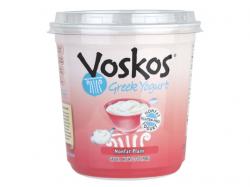Greek Yogurt: A Delicious Weapon In The Fight Against Childhood Obesity
August 29, 2012 | 4 min to read

The obesity epidemic that currently plagues this country has now spread to children. According to the Centers for Disease Control and Prevention, childhood obesity has more than tripled since 1980, with nearly one in five children now classified as obese. Although children may suffer most from the social aspects of obesity, such as teasing or low-self-esteem, obesity can also lead to bone and joint problems, and sleep apnea. Obese children who grow up to become obese adults are at a higher risk for heart disease, type 2 diabetes, stroke, several types of cancer, and osteoarthritis.
In an attempt to help mitigate this crisis, dietitians and parents alike turn to low fat diets. Dietitians and many personal trainers even claim that if you want to lose weight, you must have a caloric deficit at the end of the day. In order to achieve this you must combine diet and exercise. Right? “Not necessarily so,” says Nikko Generales, a contributor to Voskos Greek Yogurt’s “Get Fresh” blog. “Unfortunately, this old-fashioned model fails to acknowledge the findings of modern research into metabolism and the biochemical pathways of our body,” says Generales, who has a B.S. in physiology, and is currently in medical school. “The real culprit is excessive fructose consumption,” says Generales.
Fructose, like glucose, is a form of sugar. “But unlike glucose, fructose is not directly utilized by the brain and other parts of the body for energy,” says Generales. “It has to be metabolized in the liver first, in a similar fashion to that of ethanol–in other words, your liver processes fructose the same way it metabolizes a shot of whiskey,” notes Generales. “Fructose is a chronic ‘hepatotoxin,’ or chemical that is toxic to the liver.”
Generales notes that plain Greek yogurt “provides perhaps the best carbohydrate-to-protein ratio of any food. Greek yogurt is a great way to not only provide you with sustainable energy but can also double as a recovery food after strenuous exercise,” says Generales. “I recommend Voskos’ Plain Original Greek Yogurt. You can also throw in some blueberries–which are low in fructose and high in fiber–for added flavor.”
“So what can you do to help combat the child obesity epidemic? First of all, make sure your child eats more Greek yogurt. It’s high in protein and in calcium, and like fiber, it promotes a feeling of fullness and helps to avoid high-fructose snacks. Secondly, follow these basic rules when packing your child’s next school lunch,” Generales advises.
1) Avoid sugary drinks, and stick to water and milk. “Most sucrose and fructose consumption in this country comes from sugar sweetened beverages such as soda pop, energy drinks, fruit juices and flavored drink mixes,” notes Generales.
2) Eat as many non-processed foods as possible. Avoid products that are high in added sugar and preservatives.
3) Pack more raw fruits and vegetables to help increase fiber consumption. Note that fruit does contain fructose, however the ratio of fiber to fructose is high. According to Dr. Robert Lustig, a neuroendocrinology who specializes in childhood obesity, fiber can decrease the “rate of intestinal carbohydrate absorption,” “induce satiety,” and “inhibit absorption of some free fatty acids to the colon.”
4) Increase “good” fat consumption from Omega 3’s and 6’s.
Here are some healthy school lunch snacks that will help keep kids stave off childhood obesity.
1) As mentioned previously, Greek yogurt is considered a “super food” because of its high protein and high calcium content. “Your kids will also get the added benefits of probiotics,” says Generales.
2) Fruit – A piece of fruit, such as an apple, banana, or a handful of blueberries can provide kids with healthy antioxidants and fiber.
3) Cucumbers, carrots, and celery sticks with hummus dip – Eating raw vegetables is an easy way to increase fiber and vitamin consumption.
4) Kale chips – A member of the cabbage family, kale ranks high in terms of nutritional value. Kale is rich in carotenoids, anti-oxidants, and Vitamins A, K, and C. Drizzle olive oil on kale leaves and bake them in the oven until desired texture is achieved.
5) Beef or turkey jerky – A great high protein alternative to cold-cuts that doesn’t require refrigeration. Whenever possible ensure that it comes from grass-fed and free-range cows and turkeys.
Voskos Greek Yogurt (http://www.voskos.com) has been recognized in awards contests presented by Fitness magazine, Women’s Health, Vegetarian Times, Natural Solutions, Self Magazine, Prevention and Cooking Light magazine. Visit the Voskos Web site for dozens of Greek yogurt recipes (http://www.voskos.com/recipes) for high-protein, low-carbohydrate breakfasts, appetizers, entrees and snacks. Voskos Greek Yogurt, America’s first national Greek yogurt brand, is available in stores such as Kroger, Safeway, Publix, BI-LO, Whole Foods, and Sprouts.
About Voskos Greek Yogurt
Award-winning for its thick, rich taste and nutritional value, Voskos Greek Yogurt is all-natural, hormone-free, gluten-free, and Kosher certified. Through Voskos’ proprietary ProStrain™ method, Voskos yields two times more protein, more probiotics, less lactose, and a thicker, creamier consistency. Voskos offers an organic Greek yogurt line and all-natural line in both plain and blended flavors. Available nationwide, retailing between $1.49 – $2.99 in stores such as Kroger, Publix, BI-LO, Whole Foods, Sprouts, and more. For store locations and other great opportunities visit Facebook.com/Voskos.Greek.Yogurt today.
About Nikko Generales
Nikko’s passion for health and fitness stems from his aspiration to become a physician. He earned his B.S. in Physiology from the University of California, Santa Barbara and is currently working on orphan drug research at the Keck Graduate Institute of Applied Life Sciences. He believes that people should be proactive in asking questions and educating themselves on how to live a healthy lifestyle.
Source: Voskos Greek Yogurt
